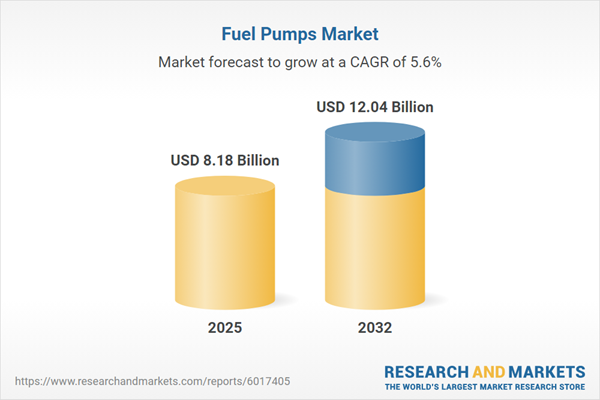Speak directly to the analyst to clarify any post sales queries you may have.
The fuel pumps market is entering a significant phase of transformation, driven by technological innovation, evolving regulations, and changing energy usage trends. As fuel distribution methods diversify, industry players must adapt with agile, forward-looking strategies to sustain growth and stay competitive.
Market Snapshot: Fuel Pumps Market Growth Overview
The Fuel Pumps Market grew from USD 7.77 billion in 2024 to USD 8.18 billion in 2025. It is projected to continue growing at a CAGR of 5.61%, reaching USD 12.04 billion by 2032. This robust growth trajectory reflects the integration of new energy technologies, ongoing supply chain enhancements, and heightened regulatory standards across global energy networks.
Scope & Segmentation: Comprehensive Market Coverage
This research offers a detailed analysis of the fuel pumps market, covering the following key dimensions:
- Pump Types: Hybrid, Submersible, and Suction systems meeting distinct deployment needs.
- Fuel Types: Support for diesel, gasoline, and alternative fuels including biodiesel, ethanol, hydrogen, and natural gas.
- Installation Methods: Solutions for above-ground and underground requirements enhancing operational flexibility and safety.
- Flow Rate Capacities: High, medium, and low flow pumps tailored to different distribution scales and usage scenarios.
- Pump Materials: Use of aluminum, cast iron, and stainless steel for optimal durability and compatibility.
- Components: Includes dispensers, hoses, motors, and nozzles engineered for performance and reliability.
- Operation Modes: Automatic, hybrid, and manual interfaces supporting varied user preferences and control needs.
- End Users: Commercial businesses, industrial facilities, and retail outlets with unique maintenance demands.
- Service Provider Types: Aftermarket installers and OEM manufacturers, each focused on different stages of pump lifecycle and support.
- Distribution Channels: Online stores (official brand websites and third-party e-commerce), as well as brick-and-mortar outlets like auto parts retailers and fuel station supply stores.
- Regional Coverage: In-depth segmentation across Americas (United States, Canada, Mexico, Brazil, Argentina, Chile, Colombia, Peru), Europe, Middle East & Africa (UK, Germany, France, Russia, Italy, Spain, Netherlands, Sweden, Poland, Switzerland, UAE, Saudi Arabia, Qatar, Turkey, Israel, South Africa, Nigeria, Egypt, Kenya), and Asia-Pacific (China, India, Japan, Australia, South Korea, Indonesia, Thailand, Malaysia, Singapore, Taiwan).
- Company Analysis: Insight into competitive strategies and developments at leading firms such as ACDelco, Aisin Seiki Co. Ltd., BorgWarner Inc., Carter Fuel Systems, Continental AG, Cummins Inc., Delphi Technologies PLC, Denso Corporation, Hitachi Automotive Systems Ltd., Lear Corporation, Magna International Inc., Mahle GmbH, Mitsubishi Electric Corporation, Robert Bosch GmbH, Stanadyne LLC, TI Fluid Systems, Toyota Industries Corporation, Valeo SA, Visteon Corporation, ZF Friedrichshafen AG.
Key Takeaways for Senior Decision-Makers
- Innovation in digital monitoring and predictive maintenance algorithms is reshaping operational efficiency and service uptime across end-user segments.
- The growing prominence of alternative fuel compatibility requires tailored materials and dispensing protocols to ensure safety and seamless performance.
- Global regulatory shifts demand agile approaches to both product design and supply chain management, with particular emphasis on compliance and risk mitigation.
- New modular and scalable pump architectures enable faster component replacement and adaptability for fluctuating demand and evolving installation methods.
- Manufacturers and aftermarket installers are increasingly collaborating to streamline component sourcing and accelerate the adoption of novel fuel variants and advanced technologies.
- Regional market nuances—from environmental mandates in the Americas to infrastructure growth in Asia-Pacific—necessitate localized product strategies and support models.
Tariff Impact on Supply Chains & Costs
Recent U.S. tariff adjustments on core materials and components have directly influenced sourcing dynamics and cost structures for manufacturers and service providers. This evolving environment is prompting increased investment in domestic supply chains, alternative material research, and closer partnerships with regional distributors. End users are responding with new procurement approaches, while OEMs and installers focus on optimizing assembly efficiency and delivery timelines to ensure continuity and profitability.
Methodology & Data Sources
This analysis is grounded in a blend of primary executive interviews, engineering case studies, and secondary research from technical publications and regulatory filings. Data validation included triangulating expert perspectives with field observations, ensuring actionable insights with high levels of accuracy and reporting integrity.
Why This Report Matters
- Enables senior leaders to make informed decisions on resource allocation and innovation investments for future-ready fuel pump infrastructure.
- Equips operational teams with segmentation clarity and regional perspectives to drive market expansion and compliance assurance.
- Delivers transparent analysis on tariff impact, supply chain agility, and technology trends to power strategic planning and risk management.
Conclusion
This report offers a clear pathway for organizations to navigate the fuel pumps market’s evolving landscape. By leveraging current insights, decision-makers can chart effective strategies that align with growth opportunities and operational excellence.
Additional Product Information:
- Purchase of this report includes 1 year online access with quarterly updates.
- This report can be updated on request. Please contact our Customer Experience team using the Ask a Question widget on our website.
Table of Contents
3. Executive Summary
4. Market Overview
7. Cumulative Impact of Artificial Intelligence 2025
Companies Mentioned
The companies profiled in this Fuel Pumps market report include:- ACDelco
- Aisin Seiki Co. Ltd.
- BorgWarner Inc.
- Carter Fuel Systems
- Continental AG
- Cummins Inc.
- Delphi Technologies PLC
- Denso Corporation
- Hitachi Automotive Systems Ltd.
- Lear Corporation
- Magna International Inc.
- Mahle GmbH
- Mitsubishi Electric Corporation
- Robert Bosch GmbH
- Stanadyne LLC
- TI Fluid Systems
- Toyota Industries Corporation
- Valeo SA
- Visteon Corporation
- ZF Friedrichshafen AG
Table Information
| Report Attribute | Details |
|---|---|
| No. of Pages | 199 |
| Published | November 2025 |
| Forecast Period | 2025 - 2032 |
| Estimated Market Value ( USD | $ 8.18 Billion |
| Forecasted Market Value ( USD | $ 12.04 Billion |
| Compound Annual Growth Rate | 5.6% |
| Regions Covered | Global |
| No. of Companies Mentioned | 21 |









